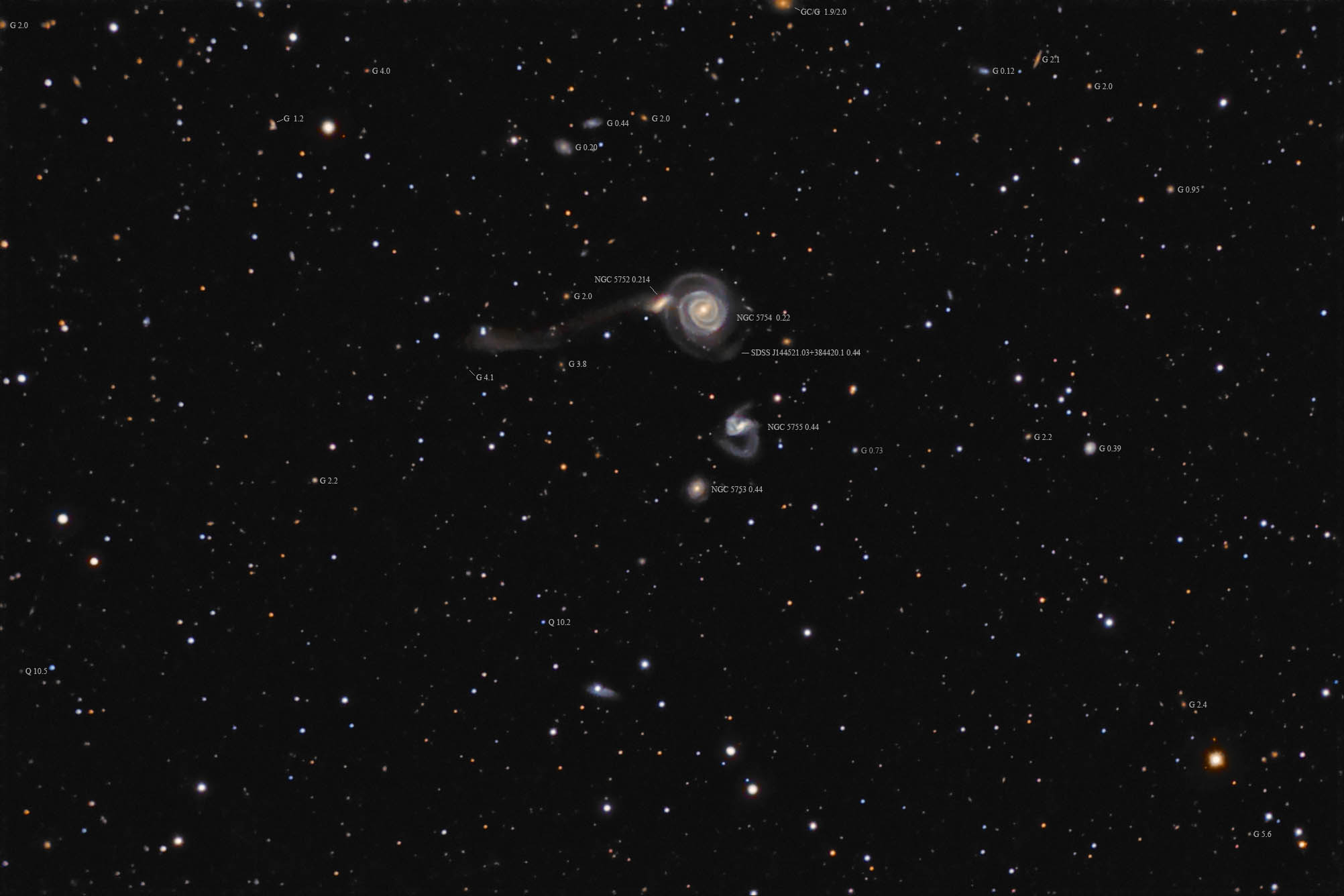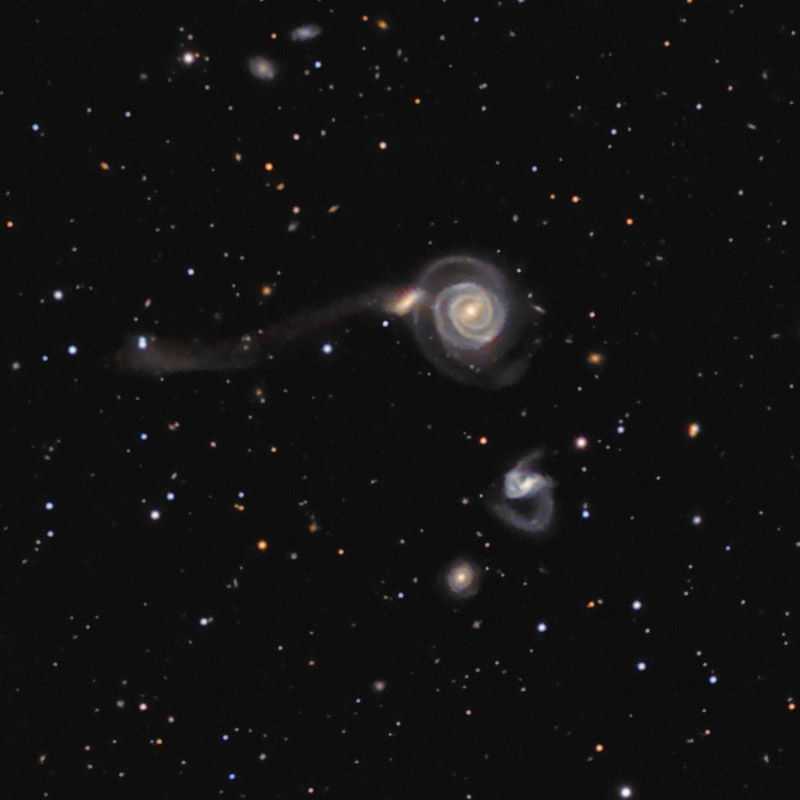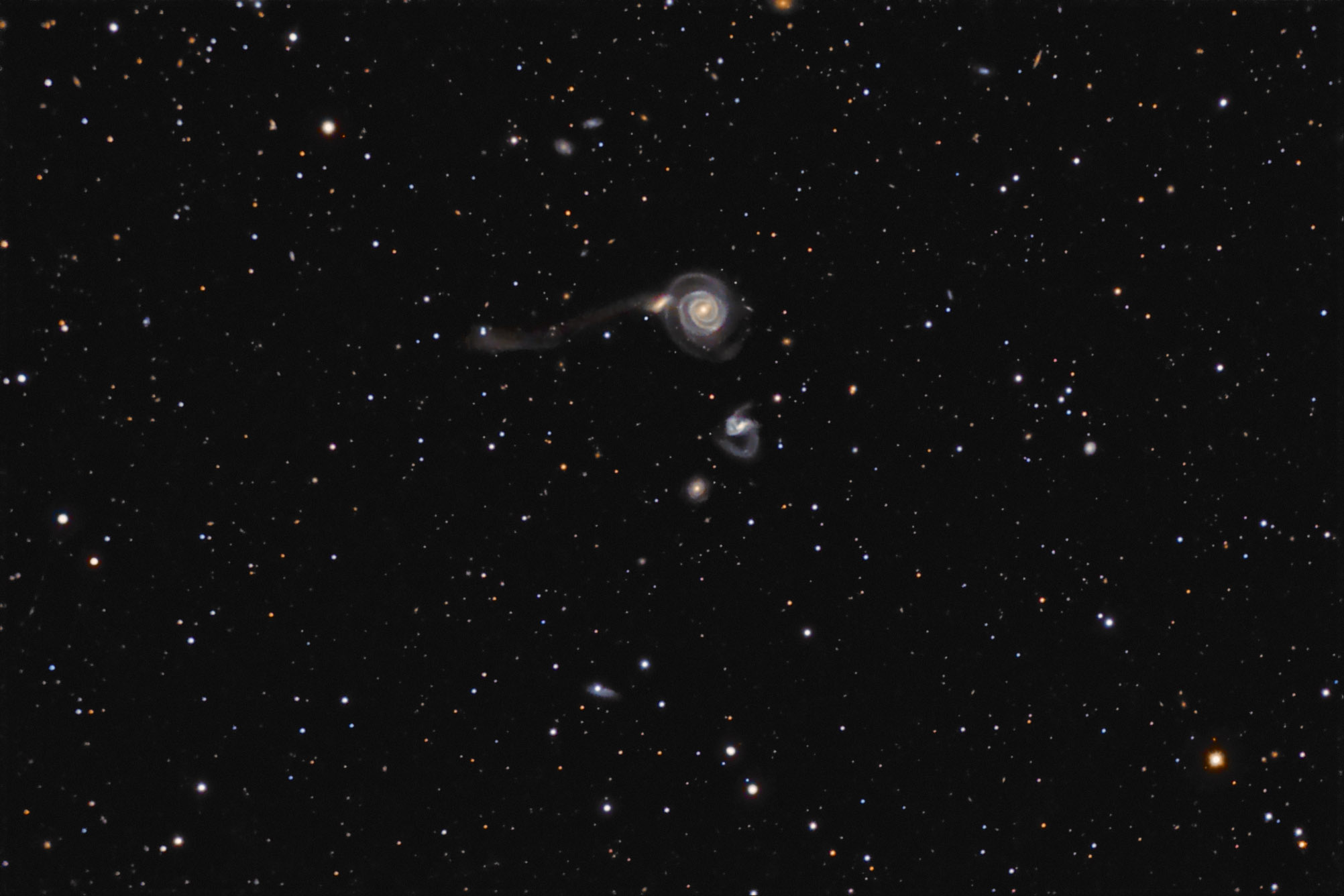| Description | Images |
Object name: ARP297Designation(s): ARP297, NGC5754, NGC5755, NGC5752, NGC5753, Arp 297 falls under Arp's category of galaxy groups, long filaments. It is located in Bootes. Its distance is a problem I'll get to. It is made up of several NGC galaxies, NGC 5752, 53, 54 and 55. When I looked at Arp's image of it I was puzzled by his comment: "Companion on arm has long tail extending westwards." The companion I assumed to be the galaxy seen atop the spiral in his image (to the left in mine) While an arm of the spiral went behind the "companion" I couldn't see that as being called a filament and it certainly didn't go west (up in Arp's photo). Then I started to image it. First 10 minute frame came in and there was a nasty reflection off to the west of the spiral. I moved the scope as that would usually stop such reflections and tried again. But there it was and it didn't move in relation to the stars. So it must be real. I looked at the GIF version of the POSS plates and saw a hint of something. I enhanced these and yes it was there though my "reflection" was much larger. I downloaded the Sloan image which showed it clearly and now I could see the real long filament Arp was talking about. I can't see but a faint hint of it in the scanned version of his photo but sure could in my frames and the SDSS image. I moved it back where it was for the first image and took 7 more. I didn't use the moved frame as it would result in the image being rather cropped by several minutes. Related Designation(s):2MASS J14451413+3843436, 2MASS J14451888+3848211, 2MASS J14451963+3843524, 2MASS J14452451+3846475, 2MASX J14451411+3843436, 2MASX J14451887+3848206, 2MASX J14451966+3843526, 2MASX J14452452+3846477, 2MASXi J1445141+384343, 2MASXi J1445188+384820, 2MASXi J1445196+384352, 2MASXi J1445245+384647, AKARI J1445243+384648, ARP 297, ARP 297 NED01, ARP 297 NED02, ARP 297 NED03, ARP 297 NED04, ARP297, ASK 311236.0, ASK 311242.0, CGCG 1443.3+3856 NED01, CGCG 1443.3+3856 NED02, CGCG 1443.4+3859 NED01, CGCG 1443.4+3859 NED02, CGCG 220-052 NED01, CGCG 220-052 NED02, CGCG 220-053 NED01, CGCG 220-053 NED02, ECO 04807, ECO 06550, FIRST J144514.1+384343, FIRST J144524.5+384647, GALEXASC J144514.28+384345.1 , GALEXASC J144519.61+384353.7 , GALEXMSC J144514.31+384344.1 , GALEXMSC J144519.59+384352.5 , HOLM 674, HOLM 674A, HOLM 674B, HOLM 674C, HOLM 674D, IRAS 14432+3856, IRAS 14434+3859, IRAS F14432+3856, IRAS F14434+3859, LDCE 1077 NED002, MAPS-NGP O_222_0426095, MCG +07-30-060, MCG +07-30-061, MCG +07-30-062, MCG +07-30-063, Mr20:[BFW2006] 33517 NED01, NGC 5752, NGC 5753, NGC 5754, NGC 5755, NGC5752, NGC5753, NGC5754, NGC5755, NPM1G +39.0358, NSA 054776, NSA 145561, NSA 145562, NSA 145567, NVSS J144514+384341, NVSS J144519+384356, NVSS J144524+384647, PGC 052685, PGC 052686, PGC 052690, PGC 052695, SDSS J144514.15+384343.8, SDSS J144514.15+384343.9, SDSS J144514.16+384343.8, SDSS J144514.16+384343.9, SDSS J144518.87+384821.2, SDSS J144518.88+384821.2, SDSS J144519.64+384352.3, SDSS J144524.58+384646.9, SDSS J144524.59+384646.9, SIG 1730, SPIDER J221.32866+38.80589, SSTSL2 J144514.15+384343.4, SSTSL2 J144518.87+384821.2, SSTSL2 J144519.70+384352.0, SSTSL2 J144524.47+384647.6, UGC 09505, UGC 09505 NOTES01, UGC 09507, UGC 09507 NOTES01, UZC J144519.6+384354, UZC J144524.5+384648, [BFW2006] J221.32866+38.80589 , [M98j] 235 NED02, [MGD2014] 1443.4+3859, [TTL2012] 131597, | Permanent link: https://images.mantrapskies.com/catalog/ARP-GALAXIES/ARP297-NGC5754-NGC5755-NGC5752-NGC5753/ARP297L8X10RGB2X10X3LR1-ROTATE-ID.JPG |


